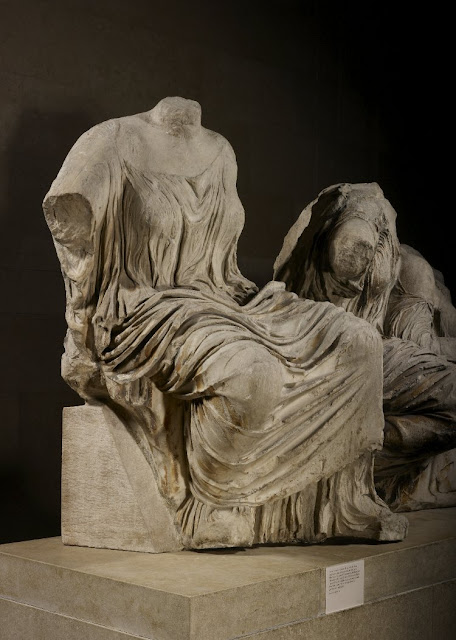 |
| Marble sculpture from the east pediment of the Parthenon British Museum |
There is solid documentation on the building of the Parthenon in Athens. All the ruinous sculptures seen here (plus several others entirely lost) were carved and installed between 438 and 432 BC. The horses of the sun fit into the tight corner on the left-hand side and the horses of the moon into the corner on the right. It is universally accepted that this group framed a central depiction of the goddess Athena's miraculous birth from the head of her father Zeus, as was appropriate over the entrance to her temple. The surviving figures have enjoyed many conjectural identities over the years. Some say they are divinities and others say they are personifications of nature. For the past two centuries these salvaged fragments have been displayed in London at the British Museum. Other significant pieces of the Parthenon are now located at the Louvre, the Vatican, and at museums in Vienna, Munich and Copenhagen, in addition to Athens.
 |
| Marble sculpture from the east pediment of the Parthenon British Museum |
 |
| Marble sculpture from the east pediment of the Parthenon British Museum |
 |
| Marble sculpture from the east pediment of the Parthenon British Museum |
 |
| Marble sculpture from the east pediment of the Parthenon British Museum |
 |
| Marble sculpture from the east pediment of the Parthenon British Museum |
 |
| Marble sculpture from the east pediment of the Parthenon British Museum |
 |
| Marble sculpture from the east pediment of the Parthenon British Museum |
 |
| Marble sculpture from the east pediment of the Parthenon British Museum |
 |
| Marble sculpture from the east pediment of the Parthenon British Museum |
 |
| Marble sculpture from the east pediment of the Parthenon British Museum |
 |
| Marble sculpture from the east pediment of the Parthenon British Museum |
 |
| Marble sculpture from the east pediment of the Parthenon British Museum |
 |
| Marble sculpture from the east pediment of the Parthenon British Museum |
 |
| Marble sculpture from the east pediment of the Parthenon British Museum |
"Fifth-century sculptors developed a broad array of techniques for suggesting bodies under drapery, and modern scholarship has responded with an equally impressive vocabulary. Ridgway, for instance, distinguishes between catenaries, eye folds, modeling lines, motion lines, omega folds, press folds, railroad tracks, ribbon drapery, sanguisuga folds, scratched drapery, selvages, swallow-tail motifs, tension folds, transparent drapery, and triangular aprons." – Richard Neer, The Emergence of the Classical Style in Greek Sculpture (University of Chicago Press, 2010)
 |
| Marble sculpture from the east pediment of the Parthenon British Museum |